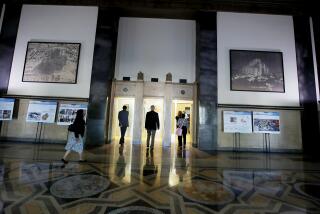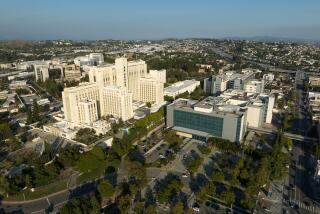Good Samaritan Dances Across a Century of Service
- Share via
Can you remember when a Model-T Ford cost $300? A five-bedroom stucco home in Beverly Hills was $5,000? Eggs were 12 cents a dozen, coffee 15 cents a pound? And a hospital room was $6 a night?
All those hard-to-believe price tags--and more--were tossed about Thursday night at the Hospital of the Good Samaritan’s Centennial Ball in the Grand Ballroom of the Beverly Wilshire Hotel.
While a commentator traced Good Sam’s roots and the rise of Los Angeles from the booming 1880s to the present, a covey of young dancers pranced through dance history--strutting like minstrels, bouncing in the jitterbug, doing the Elvis Presley pelvic rock and some flash-dancing. It’s been a long and successful stride from Episcopal nun Sister Mary Wood’s nine-bed hospital in 1885 to today’s Good Samaritan, a major medical facility and teaching institution housed in a brand-new downtown Los Angeles building that’s all paid for.
Proud Past, Bright Future
“Tonight we celebrate a proud history,” said Edward M. Benson Jr., chairman of the hospital’s board of trustees, “and a future that’s bright with promise.” He cited present and future additions as reasons for the optimism at Good Sam--a recently dedicated outpatient surgery center, a women’s health center, an education complex now under construction and a unit that will house the magnetic resonance imager, a new “non-invasive, radiation-free technology for the rapid diagnosis of many disabling disorders.”
In 1887, Sister Mary’s Los Angeles Hospital and Home for Invalids, with assets of $287, came under the care of the Episcopal Diocese of Los Angeles. Thursday night Bishop Robert Rusack, an honorary member of the hospital’s board, delivered the invocation.
It was both a historical milestone for Good Sam and the city and a lively birthday party. Joe Moshay and his violin, plus son Ray and about 12 more musicians, played from a stage banked with trees draped in tiny lights. More shimmering trees surrounded the ballroom, where tables were covered in varied pastel cloths and the centerpieces with their tall candelabra were masses of multicolored orchids, lilies and other blooms. The only thing missing was a birthday cake. (For the sweet ending to the meal, there were miniature boxes of See’s candies and chocolate layer cake with strawberry sauce.)
Thanking the Ball Committee
Chairman Benson, who had stood at the entrance to the Winter Garden greeting every guest, later thanked the Centennial Ball Committee, among them Mrs. John C. Wilson Jr. (her late husband, Dr. Wilson Jr., was chairman of the board and the man credited for the success of the building fund), Mrs. William Clayton Jr., Mrs. Robert H. Carpenter, Mrs. Jack L. Blumenthal, Mrs. Angus M. McLeod and Mrs. John A. Zaro Jr. Also taking a well-deserved bow was Good Sam’s executive director, Geneva A. Clymer.
Many generations of Good Sam supporters, volunteers, staff and administrators showed up for the black-tie birthday bash. Mrs. Webb Everett had Jimmy and Martha Kilroe and Warren and Alyce (in a slim white-and-black print) Williamson at her table. Dr. Jim Bonorris and his wife, Lucy Zahran (in Michael Novarese’s black velvet portrait-neckline dress), hosted Dr. and Mrs. Karl von Hagen (his patients included Spencer Tracy, Carole Lombard, Marion Davies), who drove down from their home in Santa Barbara; Dr. Bonorris’ associate, Dr. Paul Spears, and his wife, Susan, who is an environmental lawyer in Atty. Gen. John Van de Kamp’s office; Phil Philbrook and Patricia Huntley and Lloyd’s Bank chairman Stafford Grady and his wife Roberta.
At other tables were Mrs. Holmes Tuttle, John and Joan Hotchkis (she wore a beaded white gown), Councilman and Mrs. John Ferraro, Buckley School headmaster Walter Baumhoff, Dr. and Mrs. Grant Buckle, Jenny and Loring Rutt, Kacey and Peter McCoy, Tom and Esther Wachtell, former Ambassador to Japan and Mrs. James Hodgson (his license plate reads X Amb H), John Welborne, Mr. and Mrs. Freeman Gates, Mrs. Henry Eversole, Laura Lee and Robert Woods, and Karen King, the hospital’s director of development, who did the historical research and wrote the script.


